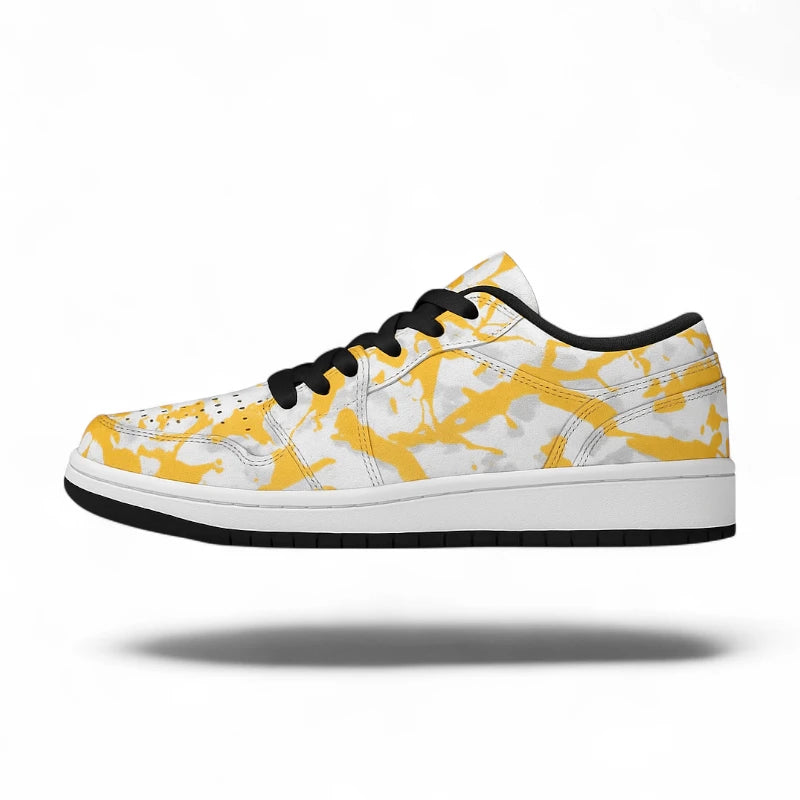Why Custom Shoes Are in Demand
The sneaker wall at your local store looks endless, yet nothing feels made just for you. That gap between “almost right” and “perfect” is why custom shoes are booming right now. Shoppers want fit, flair, and a story that sounds like their own—not a mass-made copy. Below, we unpack the forces driving this surge, drawing on hard data and everyday examples.
By the end, you’ll know why a pair from our custom low-tops collection might soon edge out the factory model in your closet.
1. Personalization Is No Longer a Perk—It’s Expected
Walk into any café and count the frappes customized to the last drizzle. That same mindset now rules footwear.
A Coherent Market Insights report shows the custom-shoe sector is set to hit US$ 14.7 billion by 2032, rising about 12 percent each year—growth fueled mostly by buyers who refuse “off the rack.” [recent market outlook](coherentmarketinsights.com)
When options feel limitless online, people stop settling. They tweak colorways, switch materials, even stitch initials. What once seemed indulgent now feels normal—a baseline promise of modern retail.
2. Fit and Comfort Trump Hype
Blisters end more nights out than broken phone batteries. Custom sizing fixes that. Brands now scan your foot in 3-D or let you choose split sizes for left and right. A sneaker built around your arch means fewer insoles and zero break-in days. Comfort soon turns to trust, and trust to loyalty.
3. Tech Makes Bespoke Affordable
Robotic stitchers, on-demand 3-D printing, and AI design tools have slashed production costs. What cost hundreds a decade ago can drop under the price of two mass-market pairs today. Lower risk for makers means more daring designs for buyers—and faster delivery. That speed keeps people hooked.
4. Sustainability Matters
Custom production dodges the “make-and-hope” model that stuffs clearance bins. Every pair has a home before it exists, so fewer end up as landfill. Shoppers who track carbon footprints see bespoke as the greener path. Some order one durable pair instead of five flimsy ones, cutting waste and saving money long-term.
5. Sneaker Culture Fuels the Craze
Limited drops taught consumers one big lesson: scarcity sells. Custom shoes flip scarcity on its head—your pair is rare because only you designed it.
That blends the exclusivity of hype culture with true personal meaning. For collectors, our custom high-tops line lets them remix classics without camping on sidewalks.
6. Health and Performance Push Demand
Runners crave arch support; basketball players need extra ankle wrap. Orthotic inserts help, but tailor-made midsoles do better. Custom sports silhouettes let athletes align stride and stance, trimming injury risk. Weekend warriors follow suit, upgrading comfort before the next 5 K.
7. The DIY Spirit
TikTok teens repaint Air Force 1s, then friends beg for pairs. One viral video can spark a micro-brand overnight. Online design labs give these hobbyists real factories behind the interface. Suddenly the line between consumer and creator blurs—and demand rises with each repost.
8. E-Commerce Removes Geographic Limits
Not long ago, bespoke meant visiting a cobbler in-person. Now a laptop handles it. Upload your design, click “order,” and track the parcel worldwide. Our custom boots collection ships to over fifty countries, proof that distance no longer blocks craftsmanship.
9. Social Proof Drives Imitation
Post a photo of shoes that match your skateboard deck, and friends want matching vibes for theirs. The cycle repeats: share, copy, iterate. Custom sneakers become social currency—visible, explainable, and unattainable in big-box aisles.
10. Rising Disposable Incomes
In many regions, middle-class wages have inched up while e-commerce discounts have pulled prices down. That gap funds small luxuries. Instead of two generic purchases each season, buyers save for one custom pair that lasts. Value shifts from quantity to identity.
11. Brands Embrace the Shift
Even giants like Nike let shoppers tweak swoosh colors or add birthdays under the tongue. They see the same surveys we do: Forbes cites 81 percent of consumers preferring companies that remember their preferences and 70 percent willing to spend more for that touch. [customer preference study](forbes.com)
When titans invest in bespoke tech, supply chains adapt, prices drop, and expectations harden. Custom goes from niche to norm.
12. Pandemic Habits Stick Around
Lockdowns taught us to expect door-step everything. They also nudged craft hobbies and self-expression. As offices reopen, people want work shoes that still speak the home-desk color palette they curated for months. Little wonder customized loafers and sandals surged.
13. Gift-Giving Upgrade
Instead of guessing a friend’s size at the mall, you send a gift card that unlocks their own design portal. They create, you pay, nobody lines up for returns. Seasonal spikes in bespoke vouchers show this model gaining fans.
14. Storytelling Sells
A monogram or hometown map stitched on canvas tells a tale each time you walk. Stories spread faster than logos. Friends repeat them, strangers ask, and the shoe becomes an icebreaker. Marketing teams now build campaigns around “design your journey,” not “buy our SKU.”
15. Future Outlook
AR mirrors will soon let you “wear” designs in real time. Materials grown in labs could match your foot’s micro-climate. Customization may blend with repair services, so a worn sole signals update rather than landfill. Expect the border between design, purchase, and upkeep to fade.
Key Takeaways
-
Personal fit rivals price. Comfort wins hearts and repeats orders.
-
Tech drives down cost. 3-D tools make bespoke quick and scalable.
-
Green is good. Made-to-order lowers excess stock and waste.
-
Identity beats uniformity. Shoes now tell stories, not just sizes.
